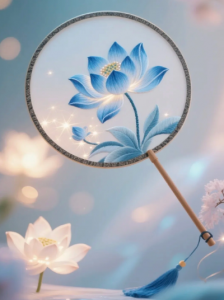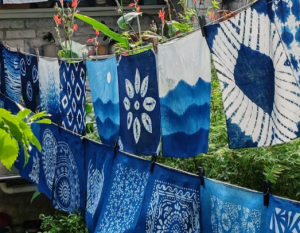In the annals of Chinese art and craftsmanship, few objects embody the exquisite fusion of utility, art, and symbolism as perfectly as the Imperial Round Fan (宫廷团扇, Gōngtíng Tuánshàn). More than a mere tool for cooling, the round fan was a cherished accessory in the imperial courts, a canvas for supreme artistry, and a silent language of status and sensibility. This elegant artifact stands as a testament to China’s rich cultural heritage, where even a gentle breeze was filtered through a lens of breathtaking beauty.
A Symbol of Status: Historical Origins and Evolution
The history of the round fan in China is long and storied, with its significance evolving dramatically over centuries.
-
Early Origins (Western Han Dynasty – 206 BC to 24 AD): The earliest round fans, known as tuánshàn (团扇) or “round fan,” were made of plain white silk stretched over a bamboo frame. They were initially used by palace attendants to shield the emperor from dust and wind, as much as to provide cooling. Their circular shape (圆, yuán) was deeply symbolic, representing union, perfection, and the fullness of the moon.
-
Golden Age (Tang and Song Dynasties – 7th to 13th Centuries): This period marked the zenith of the round fan’s cultural status. It became an indispensable accessory for court ladies and literati. The fan transformed into a portable canvas, with poets inscribing verses and painters depicting delicate landscapes, flowers, and birds on its silk surface. It became a symbol of feminine grace and scholarly refinement.
-
The Imperial Context: Within the palace walls, the fan was a strict indicator of rank. The materials, colors, and decorations were dictated by sumptuary laws. An empress might own fans adorned with kingfisher feathers (点翠, diǎncuì), jade handles, and gold thread, while lower-ranking consorts used more modest versions. The way a fan was held and moved was part of the intricate code of courtly conduct.
An Orchestra of Craftsmanship: Materials and Techniques
Creating an Imperial Round Fan was a collaborative masterpiece, requiring the skills of multiple artisans. It was a symphony of fine materials and intricate techniques:
-
The Frame (扇框): Typically made from precious materials like aged bamboo, sandalwood, ivory, or jade. The bamboo was carefully heated and bent into a perfect circle, symbolizing harmony.
-
The Fan Surface (扇面):
-
Silk: The most common and valued material, providing a smooth surface for painting and calligraphy.
-
Paper: Sometimes used, especially for fans intended for a more scholarly aesthetic.
-
Featherwork (羽扇): A luxurious technique where feathers from kingfishers, peacocks, or cranes were meticulously layered to create iridescent patterns. Kingfisher feather art, in particular, was a hallmark of imperial luxury.
-
-
The Handle (扇柄): Often crafted from fine woods, jade, or lacquerware, and sometimes inlaid with mother-of-pearl or other semi-precious stones.
-
The Embellishments: This is where the fan truly came to life. Artisans employed:
-
Embroidery (刺绣): Using silk threads to create intricate, raised patterns on the fan’s surface.
-
Painting and Calligraphy: Often done by renowned artists, turning the fan into a priceless work of art.
-
Tassels and Pendants (流苏): Silk tassels, often with jade or precious stone accents, were attached to the handle, adding a final touch of elegance and movement.
-
The Folding Fan’s Rise and the Round Fan’s Decline
The Ming (1368–1644) and Qing (1644–1912) Dynasties saw the rise of the folding fan (折扇, zhéshàn), introduced from Japan and Korea. Favored by scholars and men for its portability and the satisfying “snap” it made when opened, the folding fan became the new fashion. The round fan, while never disappearing, gradually receded from its dominant position, becoming a more specialized and nostalgic object.
A Modern Revival: Preservation and Contemporary Development
Today, the Imperial Round Fan is experiencing a renaissance as a vital part of China’s intangible cultural heritage.
-
Cultural Recognition: The skills associated with making traditional round fans are being preserved and recognized as national and provincial-level intangible cultural heritage. Master artisans are dedicated to passing on these intricate techniques.
-
Fashion and Cultural Identity: The round fan has found a new life in modern Chinese fashion. It is a popular accessory for traditional-style photo shoots and is frequently seen in Hanfu (汉服) movements, where it complements the historical attire.
-
Contemporary Art and Design: Modern artists and designers are reinterpreting the round fan. While respecting traditional forms, they experiment with new materials, abstract designs, and contemporary themes, ensuring the art form remains relevant and dynamic.
-
Cultural Symbol: Beyond its physical beauty, the round fan remains a powerful cultural symbol. It appears in films, television dramas, and dance performances, instantly evoking a sense of classical Chinese elegance, romance, and poetic refinement.
An Enduring Breeze of Culture
The Imperial Round Fan is more than a relic; it is a swirling narrative of empire, art, and emotion. It carries the whispered secrets of the palace, the brushstrokes of poets, and the delicate touch of a bygone era’s elegance. As both a preserved tradition and a living art form, it continues to wave a gentle breeze of Chinese culture across time, reminding us that true beauty, like a cool wind on a summer day, is both timeless and essential.
猜你喜欢
发表评论
电子邮件地址不会被公开。 必填项已用*标注








